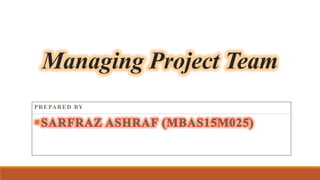This document provides an overview of managing project teams. It discusses team building, defining teams and groups, recruitment steps, establishing mission/goals/objectives, conflicts, stages of team development, and leadership. The key points are:
- A team has 3+ people linked by a common purpose, while a group performs specific tasks. Team building aligns goals and builds relationships.
- Recruitment includes job analysis, sourcing candidates, screening, and onboarding. Sources can be internal or external.
- The mission, goals, and objectives provide direction and clarity of purpose. They should be precise, attainable, measure progress, and have timeframes.
- Conflicts can be functional or











































